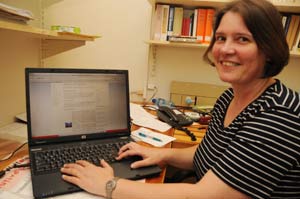Online fynbos encyclopaedia launched
10 February 2010 | Story by Newsroom Flower power: Dr Cornelia Krug and her team have made information on fynbos easy to find, thanks to a new FynbosWiki.
Flower power: Dr Cornelia Krug and her team have made information on fynbos easy to find, thanks to a new FynbosWiki.
UCT has joined forces with the University of Regensburg in Germany to start a FynbosWiki that makes information on fynbos and fynbos ecology easily accessible online.
Researchers from the two institutions are using the site to collate and exchange knowledge of the fynbos biome and beyond, and to share this with others.
"The idea originated because we researchers within the Biodiversity Monitoring Transect Analysis (BIOTA) project were looking for a way to make our research accessible to a broader audience - not just to fellow scientists via papers and conference publications," explained Dr Cornelia Krug, a BIOTA research associate based at UCT's Department of Zoology.
Krug said they also wanted other people to share their knowledge, "and a wiki where people can add or edit articles and post comments seemed for us the best way to go". Other conservation agencies, like CapeNature and the City of Cape Town, often ask for current information, such as the latest students' research, and the wiki will address this.
The wiki features articles of the month, introduces projects and people working on fynbos ecology, provides a reference database where scientific and other articles on fynbos are collected, and includes a news section, researchers' blogs and links to other sites. The site also contains contact details of principal researchers.
Krug said they had decided to focus on the fynbos region where much of their work is done, and because three of the province' four tertiary institutions have a long history of fynbos research. Their model can be easily extended to other plant biomes - or the wiki can be expanded, depending on interest.
Krug and her colleagues face some challenges as climate change and land transformation (caused by housing and agriculture), pose as a threat to the Cape Floristic Region.
"One of the vegetation types we worked in, (Renosterveld), has only 5% of its original extent left. Many plants (and animals) in the lowland are threatened."
View the FynbosWiki, and the reference data base.
 This work is licensed under a Creative Commons Attribution-NoDerivatives 4.0 International License.
This work is licensed under a Creative Commons Attribution-NoDerivatives 4.0 International License.
Please view the republishing articles page for more information.










